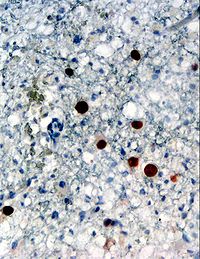
Photo from wikipedia
The human neurotropic virus JCPyV, a member of the Polyomaviridiae family, is the opportunistic infectious agent of Progressive Multifocal Leukoencephalopathy (PML), a fatal disease seen in severe immunosuppressive conditions and,… Click to show full abstract
The human neurotropic virus JCPyV, a member of the Polyomaviridiae family, is the opportunistic infectious agent of Progressive Multifocal Leukoencephalopathy (PML), a fatal disease seen in severe immunosuppressive conditions and, during the last decade, in patients undergoing immunotherapy. JCPyV is a ubiquitous pathogen with up to 85% of the adult population word-wide exhibiting antibodies against it. Early experiments demonstrated that direct inoculation of JCPyV into the brain of different species resulted in the development of brain tumors and other neuroectodermal-derived neoplasias. Later, several reports showed the detection of viral sequences in medulloblastomas and glial tumors, as well as expression of the viral protein T-Antigen. Few oncogenic viruses, however, have caused so much controversy regarding their role in the pathogenesis of brain tumors, but the discovery of new Polyomaviruses that cause Merkel cell carcinomas in humans and brain tumors in racoons, in addition to the role of JCPyV in colon cancer and multiple mechanistic studies have shed much needed light on the role of JCPyV in cancer. The pathways affected by the viral protein T-Antigen include cell cycle regulators, like p53 and pRb, and transcription factors that activate pro-proliferative genes, like c-Myc. In addition, infection with JCPyV causes chromosomal damage and T-Antigen inhibits homologous recombination, and activates anti-apoptotic proteins, such as Survivin. Here we review the different aspects of the biology and physiopathology of JCPyV.
Journal Title: Frontiers in Oncology
Year Published: 2019
Link to full text (if available)
Share on Social Media: Sign Up to like & get
recommendations!